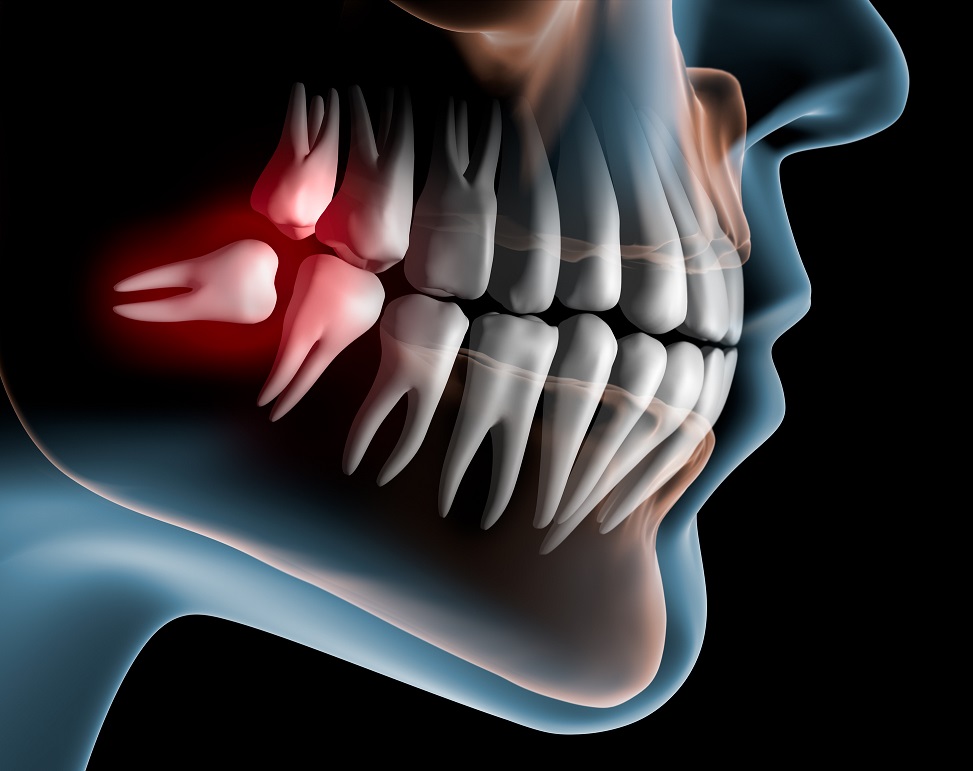
Wisdom Teeth Extractions
Wisdom teeth, or third molars, are the last permanent teeth to appear (erupt) in the mouth. These teeth usually appear between the ages of 17 and 25. Some people never develop wisdom teeth. For others, wisdom teeth erupt normally – just as their molars did – and cause no problems.
Why It’s Done
Many people develop impacted wisdom teeth – teeth that don’t have enough room to erupt into the mouth or develop normally. Impacted wisdom teeth may erupt only partially or not at all.
An impacted wisdom tooth may:
- Grow at an angle toward the next tooth (second molar)
- Grow at an angle toward the back of the mouth
- Grow at an angle to the other teeth, as if the wisdom tooth is “lying down” within the jawbone
- Grow up or down like other teeth but stay trapped within the jawbone
Problems with Impacted Wisdom Teeth
You’ll likely need your impacted wisdom tooth pulled if it results in problems such as:
- Pain
- Trapping food and debris behind the wisdom tooth
- Infection or gum disease
- Tooth decay in a partially erupted wisdom tooth
- Damage to a nearby tooth or surrounding bone
- Development of a fluid-filled sac (cyst) around the wisdom tooth
- Complications with orthodontic treatments to straighten other teeth
What You Can Expect
Prior to the procedure your dentist will administer local anesthesia with one or more injections near the site of each extraction. Before you receive an injection, a topical will be applied to your gums to numb them. You’re awake during tooth extraction. You may feel some pressure or movement, but your shouldn’t experience pain.
During wisdom tooth extraction, your dentist will:
- Make an incision in the gum tissue to expose the tooth and bone
- Remove bone that blocks access to the tooth root
- Divide the tooth into sections if it’s easier to remove in pieces
- Remove the tooth
- Clean the site of the removed tooth of any debris from the tooth or bone
- Stitch the wound closed to promote healing, though this isn’t always necessary
- Place gauze over the extraction site to control bleeding and to help a blood clot form
After the Procedure
As you heal from your surgery, follow your dentist’s instructions.
- Bleeding. Bite firmly on the gauze for 3 hours (unless directed otherwise). Do not change your own gauze. Some oozing of blood may occur the first day after wisdom tooth removal. Try to avoid excessive spitting so that you don’t dislodge the blood clot from the socket.
- Pain Management. You should be able to manage pain with an over-the-counter pain reliever (Ibuprofen and Acetaminophen) as instructed by your dentist.
- Swelling and Bruising. Holding an ice pack against your jaw will help with swelling and bruising. Repeat a routine of 10 minutes on followed by 5 minutes off for the 3 hours you are biting on gauze. Swelling usually reaches its peak on or around day 3.
- Activity. After your surgery, plan to rest for the remainder of the day. You can resume normal activities the next day. Keep your heart rate down and stay elevated (your head above your body).
- Food and Beverages. Eat and drink only soft cold foods such as yogurt, applesauce, smoothies and milkshakes. DO NOT drink with a straw because the sucking action could dislodge the blood clot from the socket. Avoid hard, chewy, hot or spicy foods that might get stuck in the socket or irritate the surgery site.
- Cleaning Your Mouth. Do not brush your teeth, rinse your mouth, spit or use mouthwash during the first 24 hours after surgery. Once you begin brushing again, be gentle near the surgical site. After 24 hours rinse gently with warm salt water (1 tsp salt to 8oz warm water). Repeat as directed.
- Tobacco Use. If you smoke, don’t do so for at least 72 hours after surgery – and wait longer than that if possible. If you chew tobacco, don’t use it for at least a week. Using tobacco products after oral surgery can delay healing and increase the risk of complications.
- Stitches. If you had stitches placed, they will need to be removed 5-7 days after your surgery
When to Call Your Dentist
Call your dentist if you experience any of the following signs or symptoms, which could indicate an infection, nerve damage or other serious complication:
- Difficulty swallowing or breathing
- Excessive bleeding
- Fever
- Severe pain not relieved by medications
- Swelling that worsens AFTER 3 days
- A bad taste in your mouth not removed by saltwater rinses
- Pus in or oozing from the socket
- Persistent numbness or loss of feeling
- Blood or pus in nasal discharge
You probably won’t need a follow-up appointment after a wisdom tooth extraction if:
- You didn’t need stitches removed
- No complications arose during the procedure
- You don’t experience persistent problems, such as pain, swelling, numbness or bleeding – complications that might indicate infection, nerve damage or other problems
Leave a reply →
